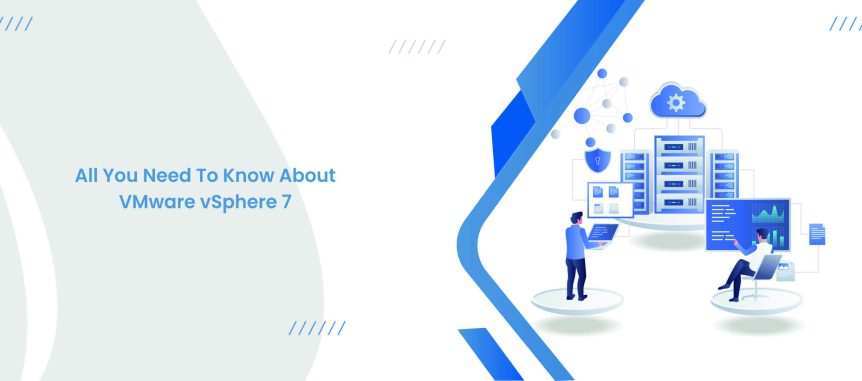VMware vSphere 7 is the finest hardware virtualization platform. VMware vSphere 7 is used all across the globe and it is quite popular and powerful.
In general, most users can automatically associate virtualization with VMware.
VMware is known for its high performance, better reliability, and great usability. On April 2, 2020, the official vSphere 7 was released, and vSphere 7 is considered the latest virtualization platform and many exciting features have been added to it.
For version 7, VMware vSphere is rearchitected. In this blog, we will discuss about the new features in vSphere 7 that will help in deciding whether it is worth not updating vSphere 7 for the present version of vSphere.
1. Integration and Kubernetes Support in VMware vSphere 7
VMware vSphere 7 is completely integrated with Kubernetes. Kubernetes are known for running containers in a cluster.
Kubernetes offers scalability, high availability, and load balancing. For administrators, now it is easier to run and handle Kubernetes clusters.
2. Clustering Characteristics Improvement
In VMware vSphere 7, an improvement has been made in the VMware Distributed Resources Scheduler (DRS) cluster.
DRS holds the capacity of load balancing for both containers and VMs.
In earlier versions of vSphere 7, the DRS aimed at load balancing of the ESXi host. But, in VMware vSphere 7, DRS’s main task is to care about virtual machine goodness instead of focusing on the ESXi host utilization.
It means we get enough resources and a proper workload-centric approach from the redesigned DRS.
There is more resource optimization in VMware vSphere 7’s DRS (Distributed Resources Scholar) and it can count resources’ utilization every minute.
In the previous versions of vSphere, 5 minutes was the minimum checking interval.
3. VMware vMotion
In between ESXi hosts, VMware vMotion offered VM migration without causing an interruption in VM operation.
Enhancements in VMware vSphere 7 lead to less resource consumption for live VM migration. Also, it reduces stun time. It results in improving the degraded performance of live migration.
4. vCenter Upgrade
The new vCenter helps in the right management and simplifies operations with new features of VMware.
Now, vCenter 7 can’t be installed on a Window machine. Rather, the deployment of VMware vCenter 7 can take place only as a virtual appliance (VCSA – vCenter Server Appliance) based on a photon OS (a Linux-based operating system maintained by VMware.
vCenter Server 7 is merged with the Platform Service Controller. There is an increment in Configuration maximums for vCenter 7.
5. ESXi Similarity.
Guest operating system’s current versions are supported in vSphere 7 which consists of Ubuntu 19, CentOS 8. x, Windows Server 2019, and SUSE Linux 11.x, Red Hat Enterprise Linux 8.x and many others.
Hardware version 4 (ESXi 3. x) of virtual machines and later can be run on ESXi 7. Older versions of VMs aren’t supported.
For example, The virtual machine hardware version 17 is accessible for ESXi 7 but is not obtainable for earlier versions of ESXi.
6. High Levels of Security
VMware vSphere 7 offers high-security levels. It encourages MFA (Multi-Factor Authentication) by utilizing Identity Federation.
Moreover, password policies are good. vSphere Trust Authority (VTA) is a brand-new technology that builds its management cluster.
The VTA management cluster distributes encryption keys for the KMS (Key Management Servers)
7. Upgraded vSAN
vSAN is updated in VMware vSphere 7. VMware vSAN is an element that is used to create a hyper-converged environment.
In the latest version, improvements have been made, including simplification of provisioning, supported NFS v.3 and v.4.1, support for larger capacity devices, memory optimization, and VM storage usage’s improved reporting, etc.
8. No VNC Server
To handle and manage running VMs, some of the users prefer the use of a VNC server. But, if you wish to use vSphere 7, then, a built-in VNC server is not available.
Rather, to manage VMs, VMware Remote Console or VM Console can be used.
9. Licensing and Editions in VMware vSphere 7
Unlike vSphere 6.7, vSphere 7 follow a distinct licensing model. It is licensed based on a pre-processor.
Each CPU that is installed on an ESXi server must have at least one license. And one license can cover 32 physical cores of a processor.
If a processor on the server has more than 32 cores, then there is a requirement of assigning an additional license.
The two main editions of VMware vSphere 7 that are available for customers are vSphere 7 Standard and vSphere 7 Enterprise Plus.
The difference between the both is that vSphere 7 Enterprise Plus offers the full set of vSphere features. However, vSphere 7 Standard doesn’t support Kubernetes, has limited clustering features, and doesn’t support distributed virtual switches, host profiles, etc.
10. Conclusion
VMware vSphere 7 is a must-go. It is a new power-pack version of the enterprise-scaled virtualization platform.
In addition, VMware vSphere 7 also holds the leading place in the world of the IT sector. The current version is made with many new changes, and exciting features added to it.
With such exciting features and a lot of changes, VMware vSphere 7 is worth your attention. Other features of it include VM templates with Content Library and VMware vSphere Life Cycle Manager.
Also, the licensing model has been changed in vSphere 7 compared to vSphere 6.7. Calculate cautiously the pros and the cons, if you wish to migrate vSphere 7 from vSphere 6.
We are the best choice for your requirements if you are looking for the best VMware full-stack development services.
Connect with us to know more.
To get the latest updates, follow us on LinkedIn.
https://in.linkedin.com/company/take-2-technologies
To know more updates about the latest technologies, check out our blog section at
https://taketwotechnologies.com/blog/
Also, we would love to hear from you and solve your queries.

